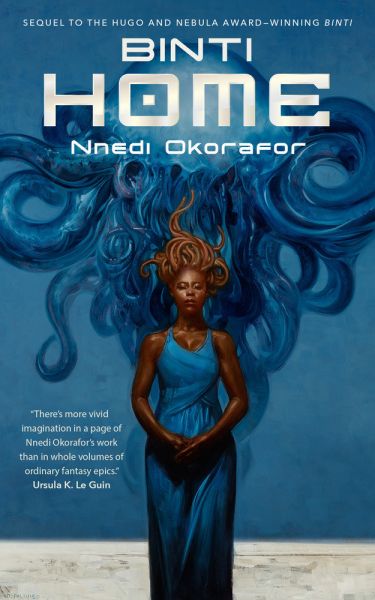Life Unfurls
Binti: Home (Binti, volume 2)
By Nnedi Okorafor

14 Feb, 2017
0 comments
2017’s Binti: Home is the sequel to Nnedi Okorafor’s Nebula and Hugo-winning Binti.
Binti has been a student at Oomza University for a year. It’s a year that has transformed her, both physically and mentally. Some of those changes were beneficial. Others, like her post-traumatic stress disorder, are not. Seeking an end to the nightmares, Binti returns to her home on Earth, in Africa, to participate in a healing pilgrimage.
Binti’s people, the Himba, enjoy ordered, predictable lives, isolated from the distractions of the greater world. They leave engaging with the universe to their arrogant, condescending Khoush neighbours. The Khoush see the Himba as ignorant rubes but at least the Himba aren’t entangled in long-running hostilities with the alien Meduse.
Binti soon discovers her people’s distaste for the unconventional extends to Binti herself. Bad enough she abandoned her designated role to go off to university. Worse that she returned a changed person, with Meduse tendrils instead of hair, and a perspective forever changed by contact with the greater galaxy. Accommodating Binti would mean making changes to the Himba way of life. Even her family sees no compelling reason to do that. Education may have cost Binti her family and people as well as her peace of mind.
More revelations await Binti out in the Namib, out in the land of the Desert People.
~oOo~
I read this before Binti, because I had a review copy set to expire in 60 days and I was not sure how long it would take me to get hold of Binti. Okorafor provides enough background that the story is comprehensible read in reverse order. I would not recommend doing it that way because it is now impossible for me to read Binti unspoiled. My own fault.
If only certain groups supplied proper documentation with their technology, this story would have been very different. Instead, circumstances force users to share what amounts to folklore about the devices in question. This makes Binti: Home cousin in its way to other stories about the desirability of solid technical documentions, stories like George O. Smith’s “Lost Art”. I would love to say shoddy documentation practices are an example of the implausible ideas SF authors use to make their plots work but my phone company uses the same “let the users share their pooled wisdom” approach in Binti: Home. I understand the attraction from the service provider point of view but do not care for it.
Some readers might be taken aback by the casual spiteful prejudice on display in Binti: Home but there’s nothing going on near the Namib that would be unfamiliar in general form to any MacDonald and Campbell, Western Canadian and Doukhobor or sports fan. Humans have an extraordinary talent for discerning very minor differences and an even greater one for drawing purportedly impenetrable social barriers on the basis of those differences.
Having established the theme of apartness, Binti: Home then proceeds to comprehensively undermine it. Not only has travel and education expanded Binti’s horizons beyond those deemed proper by the Himba and not only has her her body changed, she learns that those bold lines dividing Khoush, Himba and Desert People are merely social convention. Not only can those borders be crossed but they have been crossed. They are merely illusions.
Binti: Home is available here (Amazon) and here (Kobo).
Please direct corrections to jdnicoll at panix dot com
